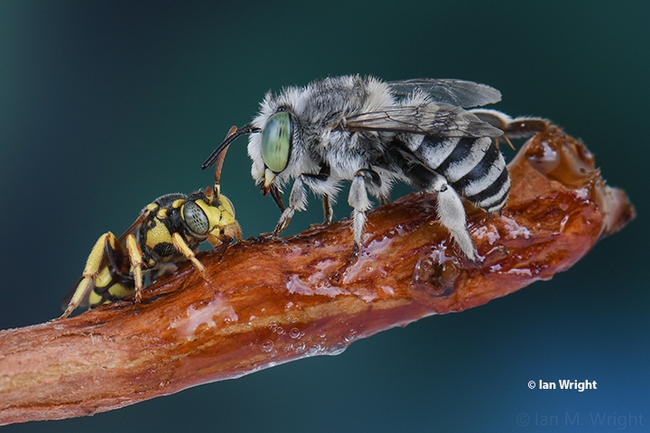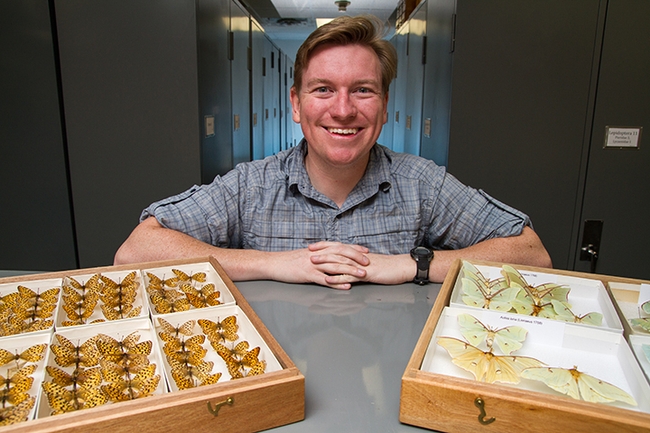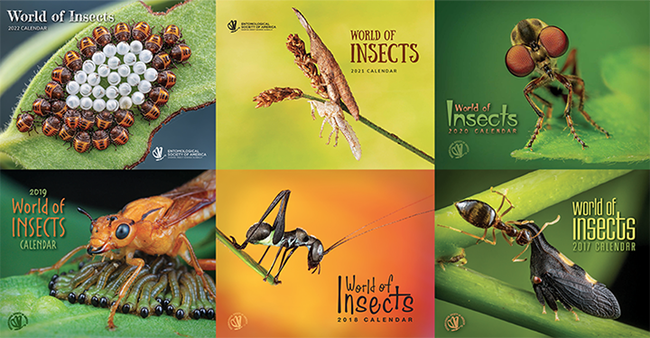- Author: Kathy Keatley Garvey
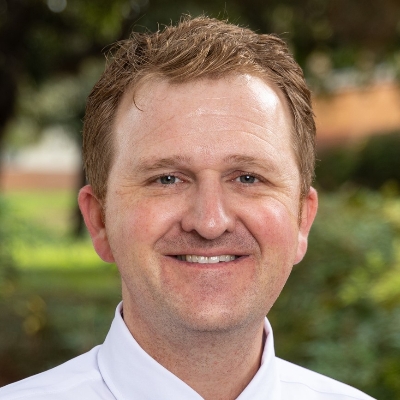
Dillman, professor and chair of the UCR Department of Nematology, will share his research in a presentation titled "Nematode Parasitism of Insects with Toxic Cardenolides," hosted by the UC Davis Department of Entomology and Nematology at 4:10 p.m., Monday, Jan. 8.
His seminar will be in Room 122 of Briggs Hall and also will be on Zoom. The Zoom link: https://ucdavis.zoom.us/j/95882849672. Associate professor and nematologist Shahid Siddique of the Department of Entomology and Nematology is the host.
Dillman holds a bachelor's degree in microbiology from Brigham Young University (2006) and a doctorate in genetics (2013) from the California Institute of Technology.
The abstract of his UC Davis seminar: 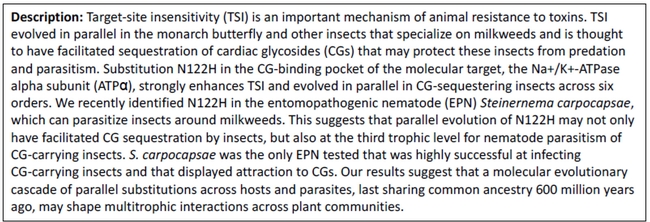
Known as an excellent investigator and teacher, Dillman won the 2022 UCR Chancellor's Award for Excellence in Undergraduate Research and Creative Achievement; the 2021 Award for Excellence in Teaching from the Society of Nematologists, and a 2020 Outstanding Investigator Award, Maximizing Investigators' Research Award (MIRA).
Check out his lab page that details his research and his guest spot on an episode on the podcast Something Offbeat. He he discussed a scientific article on a case of Ophidascaris robertsi infection in a human brain.
Seminar coordinator is Brian Johnson, associate professor, UC Davis Department of Entomology and Nematology. For Zoom technical issues, he may be reached at brnjohnson@ucdavis.edu. The complete list of winter seminars will be posted soon.
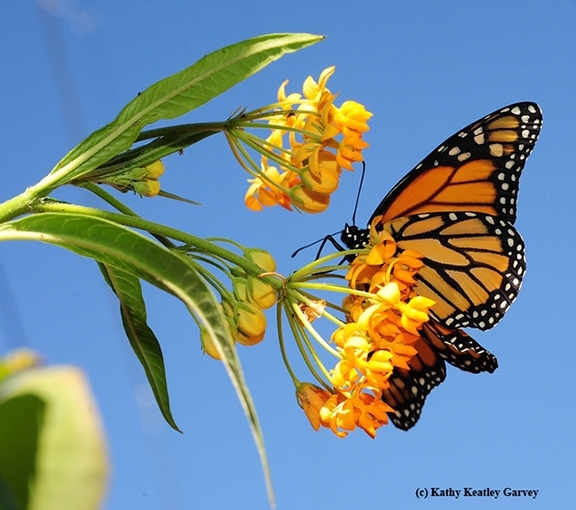
- Author: Kathy Keatley Garvey
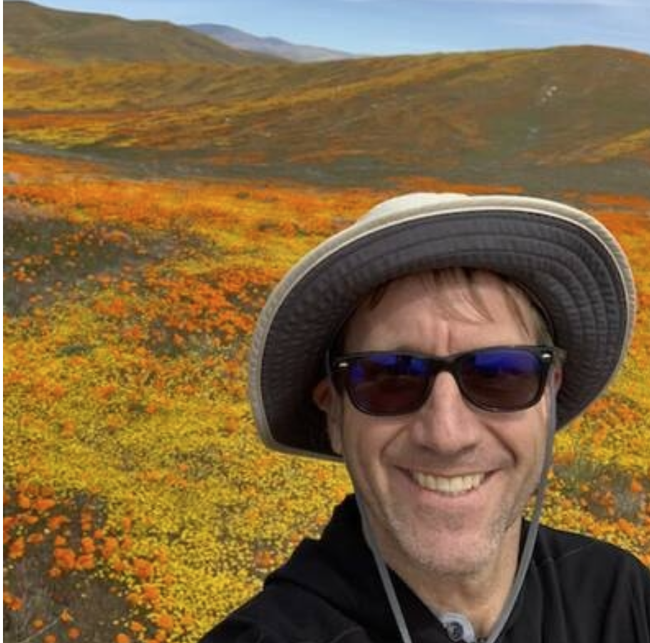
Don't bees forage only for pollen and nectar (as well as water and propolis)?
Not always so.
Some bees are meat-eaters or "bee vultures," says evolutionary biologist Quinn McFrederick of UC Riverside.
You'll want to hear McFrederick speak on "The Weird World of Pathogens, Microbes, and Meat-Eating Bees" at his Jan. 18 seminar hosted by the UC Davis Department of Entomology and Nematology.
The seminar will take place at 4:10 p.m., in 122 Briggs Hall and also will be virtual. The Zoom link:
https://ucdavis.zoom.us/j/95882849672.
"Flowers are more than just a source of food for bees; they can also act as hubs of microbial transmission," McFrederick, an assistant professor, says in his abstract. "Some pathogenic microbes can spillover from social bees into solitary species and move through plant-pollinator networks, while others have more restricted host ranges. We use a combination of fieldwork, laboratory assays, molecular ecology, and genomics to understand the evolution and ecology of these microbes. In this talk I will discuss how plant-pollinator networks can help us understand relationships between bee hosts and pathogens and other microbes."
"I will then explore the evolution of pathogenicity in the fungal genus Ascosphaera. While Ascosphaera is best known as the causative agent of chalkbrood disease, the genus is ancestrally commensal and pathogenicity has evolved independently several times. I will finish by discussing the microbiomes of bees that have reverted to a carnivorous lifestyle, the so-called bee vulture. Our ultimate goal is to leverage these symbionts to improve bee health, and we are just beginning to understand many of these weird and wonderful relationships."
McKendrick studies studies symbionts (pathogens, commensals, and mutualists) of wild and solitary bees, with the goal of leveraging these symbionts to protect bee populations and communities. His research includes a stingless species of bee in Costa Rica. He and fellow researchers "set up baits — fresh pieces of raw chicken suspended from branches and smeared with petroleum jelly to deter ants," according to a UC Riverside news story. published Nov. 23, 2021.
"The baits successfully attracted vulture bees and related species that opportunistically feed on meat for their protein," wrote Jules Bernstein. "Normally, stingless bees have baskets on their hind legs for collecting pollen. However, the team observed carrion-feeding bees using those same structures to collect the bait." McFrederick called them "little chicken baskets."
“The vulture bee microbiome is enriched in acid-loving bacteria, which are novel bacteria that their relatives don't have,” McFrederick related. “These bacteria are similar to ones found in actual vultures, as well as hyenas and other carrion-feeders, presumably to help protect them from pathogens that show up on carrion.”
The article noted that "One of the bacteria present in vulture bees is Lactobacillus, which is in a lot of humans' fermented food, like sourdough. They were also found to harbor Carnobacterium, which is associated with flesh digestion."
McFrederick and his colleagues published their research, "Why Did the Bee Eat the Chicken? Symbiont Gain, Loss, and Retention in the Vulture Bee Microbiome?" in the Nov. 21, 2021 edition of the American Society for Microbiology.
"Diet and gut microbiomes are intricately linked on both short and long timescales," they wrote in their abstract. "Changes in diet can alter the microbiome, while microbes in turn allow hosts to access novel diets. Bees are wasps that switched to a vegetarian lifestyle, and the vast majority of bees feed on pollen and nectar. Some stingless ;bee species, however, also collect carrion, and a few have fully reverted to a necrophagous lifestyle, relying on carrion for protein and forgoing flower visitation altogether. These vulture bees belong to the corbiculate apid clade, which is known for its ancient association with a small group of core microbiome phylotypes. Here, we investigate the vulture bee microbiome, along with closely related facultatively necrophagous and obligately pollinivorous species, to understand how these diets interact with microbiome structure."
McFrederick holds a bachelor's degree in integrative biology (1992) from UC Berkeley, and a master's degree in conservation biology (2004) from San Francisco State University, where he studied with advisor Gretchen LeBuhn. He went on to receive his doctorate in biology in 2010 from the University of Virginia, where he was advised by Douglas Taylor.
Among his awards:
- 2017: Hellman Fellowship
- 2016: Outstanding Faculty Award from the UCR Entomology Graduate Student Association.
- 2010: Award for Excellence in Scholarship in the Sciences from the Vice-President for Research, University of Virginia. The award recognizes “excellence in original scholarship by Ph.D. students at the University”
- 2010: Graduate Teaching Assistant Award from the Department of Biology, University of Virginia
The UC Davis Department of Entomology seminars, coordinated by urban landscape entomologist Emily Meineke, assistant professor, are held on Wednesdays through March 15. (See schedule.) Eight of the 10 will be in-person in 122 Briggs Hall, and all will be virtual.
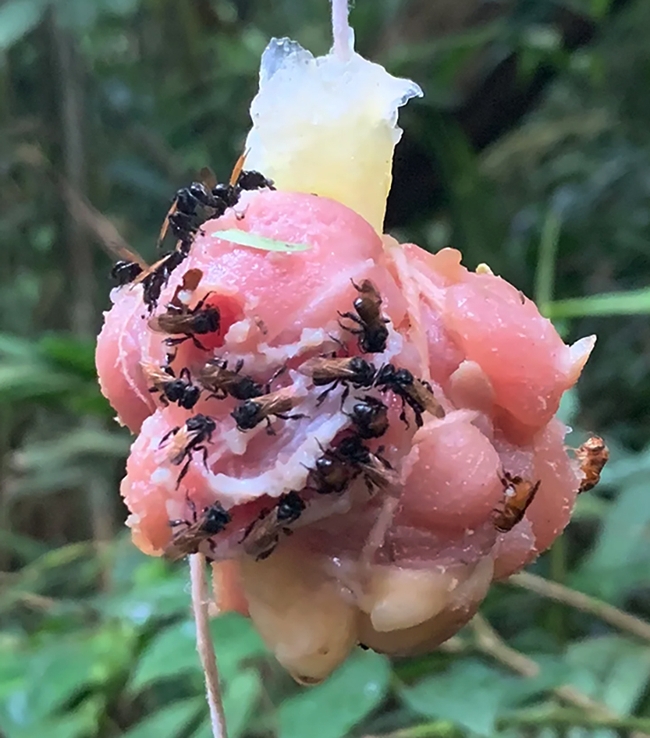
- Author: Kathy Keatley Garvey
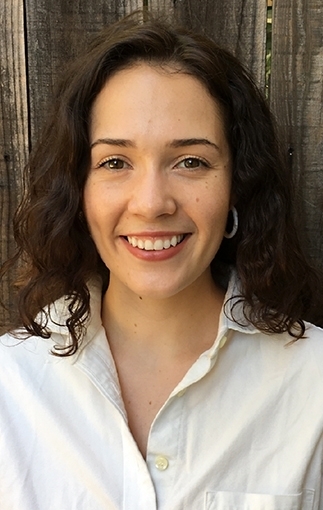
The award-winning trio:
- Medical entomologist-geneticist Geoffrey Attardo received the Medical, Urban, and Veterinary Entomology Award. (See news story)
- Doctoral student Erin Taylor Kelly of the Attardo lab won the Student Leadership Award (See news story)
- Undergraduate entomology student Gwen Erdosh of the Louie Yang lab and a member of the Research Scholars Program in Insect Biology, won the inaugural Dr. Stephen Garczynski Undergraduate Research Scholarship (See news story)
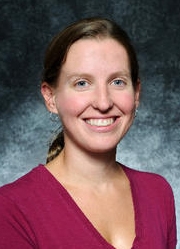
Rankin says her research "focuses on investigating species interactions and their effects on trophic dynamics and ecosystem services within the contexts of invasion biology, community ecology and evolutionary ecology." She received her bachelor's degree in biology in 2002 from Georgetown University, Washington, DC, and obtained her doctorate in biological sciences from UC San Diego in 2009. Then it was off to UC Davis for a year in the Yang lab before accepting a position as postdoctoral researcher with the University of Maryland's Department of Entomology. Rankin joined the UC Riverside faculty in 2013 as an assistant professor and advanced to associate professor in 2019.
In 2021 Rankin was named the recipient of two major awards: the Outstanding Faculty Mentor and the Academic Senate Distinguished Teaching Award. See her research and publications on her website.
Rankin's award was one of five awarded to UC Riverside entomologists:
- Mark Hoddle won the C. W. Woodworth Award
- Jessica Purcell, Distinction in Student Mentoring Award
- Dong-Hwan Choe, Distinguished Achievement in Extension Award
- Kerry Mauck, Plant-Insect Ecosystems Award
Results showed UC entomologists (from the two campuses) winning a total of eight awards, and USDA, four. (See the chart below) Congratulations, all!
Pacific Branch. The Pacific branch encompasses 11 Western states, parts of Canada and Mexico and several U.S. territories.
In the United States: Alaska, Arizona, California, Hawai, Idaho, Montana, Nevada, Oregon, Utah, Washington, Wyoming
U.S. Territories: American Samoa, the Federated States of Micronesia, Guam, Johnston Atoll, Commonwealth of the Northern Mariana Islands, Midway Islands, Wake Island
In Canada: Alberta, British Columbia, Northwest Territories, Saskatchewan, Yukon
In Mexico: Baja California, Baja California Sur, Sinaloa, Sonora
ESA, founded in 1889, is the world's largest organization serving the professional and scientific needs of entomologists and individuals in related disciplines. Its 7,000 members are affiliated with educational institutions, health agencies, private industry, and government. They are researchers, teachers, extension service personnel, administrators, marketing representatives, research technicians, consultants, students, pest management professionals, and hobbyists.
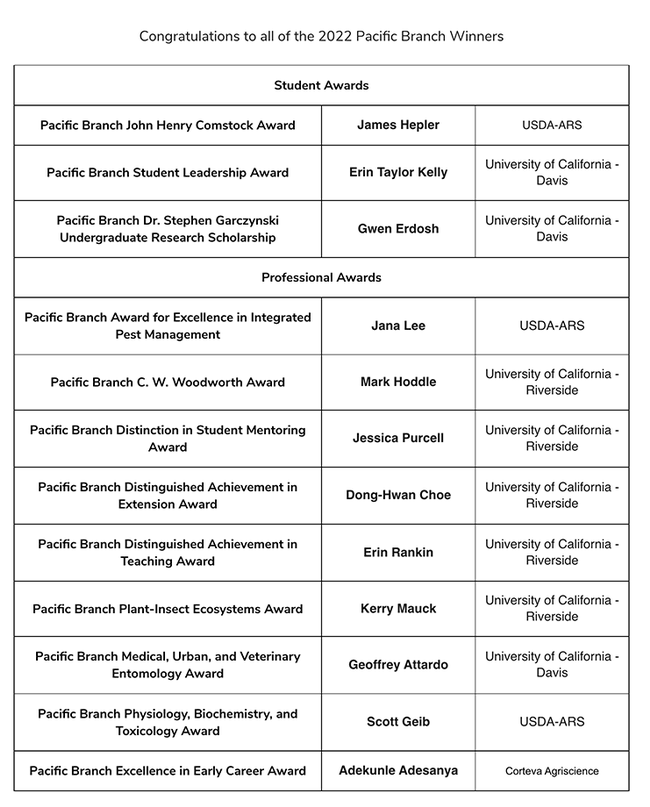
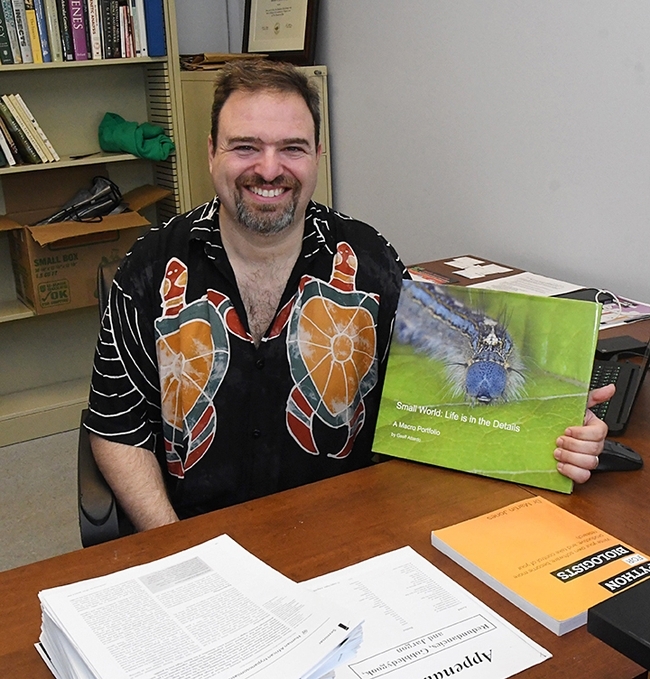
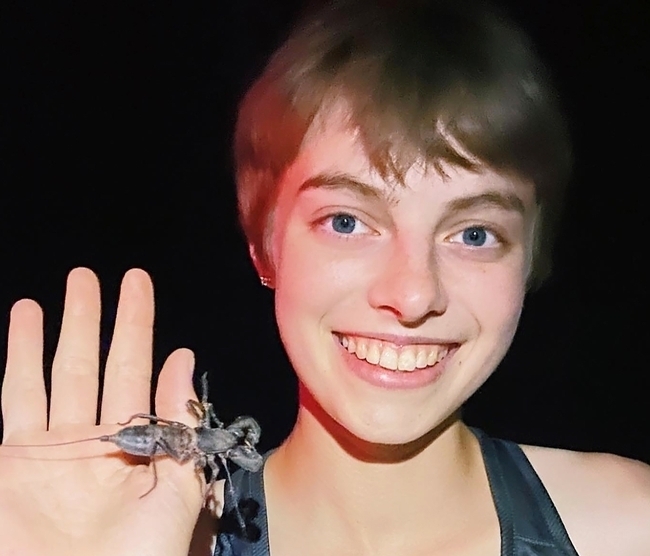
- Author: Kathy Keatley Garvey
"Scientists now understand how certain animals can feed on picturesque, orange monarch butterflies, which are filled from head to abdomen with milkweed plant toxins.
"In high enough concentrations, milkweed can kill a horse, or a human. To be able to eat this plant, monarchs evolved a set of unusual cellular mutations. New UC Riverside research shows the animals that prey on monarchs also evolved these same mutations.
"A Current Biology journal article, published Nov. 22, 2021, describes the research that revealed these mutations in four types of monarch predators — a bird, a mouse, a parasitic wasp, and a worm." --EurekAlert.
The leading author of that research article, evolutionary biologist Simon "Niels" Groen, an assistant professor at UC Riverside, will discuss "Plant Toxins and the Evolution of Host-Parasite Interactions" when he presents a seminar to the UC Davis Department of Entomology and Nematology at 4:10 p.m., Wednesday, Feb. 2 in 122 Briggs Hall.
He will speak in person. The lecture also will be broadcast simultaneously on Zoom. The Zoom link: https://ucdavis.zoom.us/j/99515291076.
"Plants interact with incredibly diverse groups of animals including plant-feeding insects and nematodes as well as their natural enemies," Groen says in this abstract. "These interactions are influenced by toxic defensive chemicals that plants make. In my talk, I will focus on how plants evolved variation in production of these defensive chemicals and how animal parasites in turn evolved mechanisms enabling them to handle such toxins."
Groen, who joined the UC Riverside faculty in July 2021 following his postdoctoral research position (2014 to 2021) in the Noah Whiteman laboratory, Department of Ecology and Evolutionary Biology, University of Arizona, focuses his research on "understanding molecular mechanisms of adaptation in the context of species interactions and fluctuating environmental conditions."
A native of the Netherlands, he received his bachelor's degree and masters degree in biology from Wageningen University, Netherlands, and his doctorate in plant sciences from the University of Cambridge, UK.
Groen served as a visiting researcher from 2007 to 2008 in the Department of Multi-Trophic Interactions, Netherlands Institute of Ecology, and as a visiting researcher from 2008 to 2012 in the Department of Organismic and Evolutionary Biology, Harvard University.
"Growing up in The Netherlands, I became fascinated with plants and their responses to ever-changing environmental conditions while working as a 'ziekzoeker' in tulip fields outside of school hours," he writes in an author profile on the American Society of Plant Biologists website. The site featured him as the first author of “Evolutionary Systems Biology Reveals Patterns of Rice Adaptation to Drought-Prone Agro-Ecosystems," published Nov. 15, 2021 in the journal Plant Cell.
"A 'ziekzoeker' looks for diseased plants and I searched in particular for variegated white and red tulips--the ones you'd recognize from a golden-age Dutch still life painting," Groen related. "I learned how these tulips are infected with an aphid-transmitted virus and during my PhD in the group of John Carr at the University of Cambridge, I would further investigate the molecular mechanisms of how virus infections would change plant interactions with aphids and pollinators. I was gripped by the role that plant defensive chemicals play in shaping species interactions and I continued to study these as a postdoc with Noah Whiteman at the University of Arizona and the University of California, Berkeley.'
On the author page, he chronicled his previous work on the interactions between milkweeds and the monarch butterfly "and found out how the monarch evolved resistance to the cardenolide toxins that milkweeds make. While this work mostly revolved around a single gene of large effect, typically several or many genes are involved in organisms' evolutionary responses. As a Gordon and Betty Moore Foundation fellow in the group of Michael Purugganan at New York University, I learned about the latest developments in evolutionary genomics and systems biology while investigating patterns of natural selection on gene expression in rice populations that we grew under wet and dry field conditions with our collaborators at the International Rice Research Institute in The Philippines."
"The current paper (Plant Cell) is a culmination of this research," Groen related. "We found that under field drought rice plants do not just respond to changes in water availability, but also to concomitant changes in abundance of soil microbes that they interact with. As assistant professor in the Department of Nematology at the University of California, Riverside, I will continue to study rice and milkweed as well as plants from the nightshade family and look at the complex evolutionary tug-of-war between these plants and parasitic nematodes. Combining laboratory and field experiments, we will zoom in on the central role that plant chemicals play by using approaches from evolutionary and systems biology like the ones we describe in our paper."
Nematologist Shahid Siddique, assistant professor in the Department of Entomology and Nematology, coordinates the winter quarter seminars. He may be reached at ssiddique@ucdavis.edu for any technical issues involving the Zoom connection.
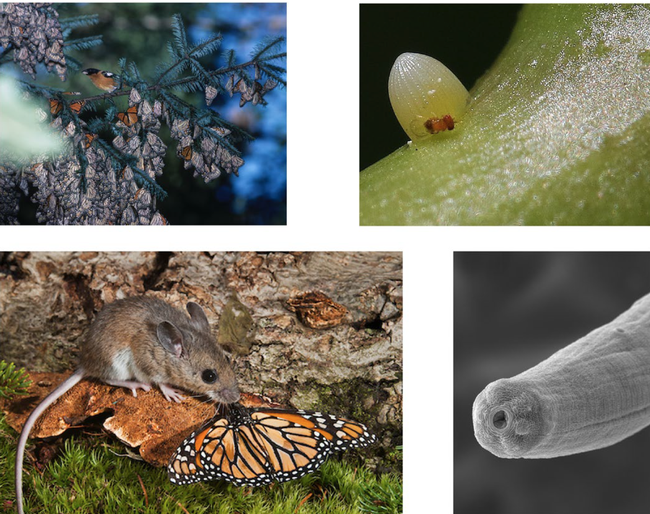
- Author: Kathy Keatley Garvey
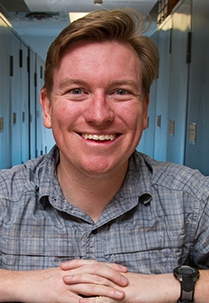
His work shows a cuckoo bee (Nomada sp.) and an Anthophora bee sharing honey on a twig. The image appears as an inset for the month of September.
Wright collected the bees at his field site in Hemet Calif., the day before. "I took them to my studio to try and get some images in flight and to bolster my files of native bee species," he related. "I often feed my subjects a little honey as I photograph them over the course of a day or two before releasing them back where I found them. They also tend to offer nice shots when they sit still drinking, so I figured I would try to fit two bees on a twig that I had around, and see if they would offer a picture."
"I managed a number of nice shots of them sharing a drink before letting them go their separate ways. Once spring starts back up in full, I'm hoping to recreate this shot with a half-dozen or more native bee species all on the same branch at the same time to show off the incredible diversity of native bees in California."
"I was so thrilled to have my image accepted to the ESA calendar, which always showcases incredible arthropod images!"
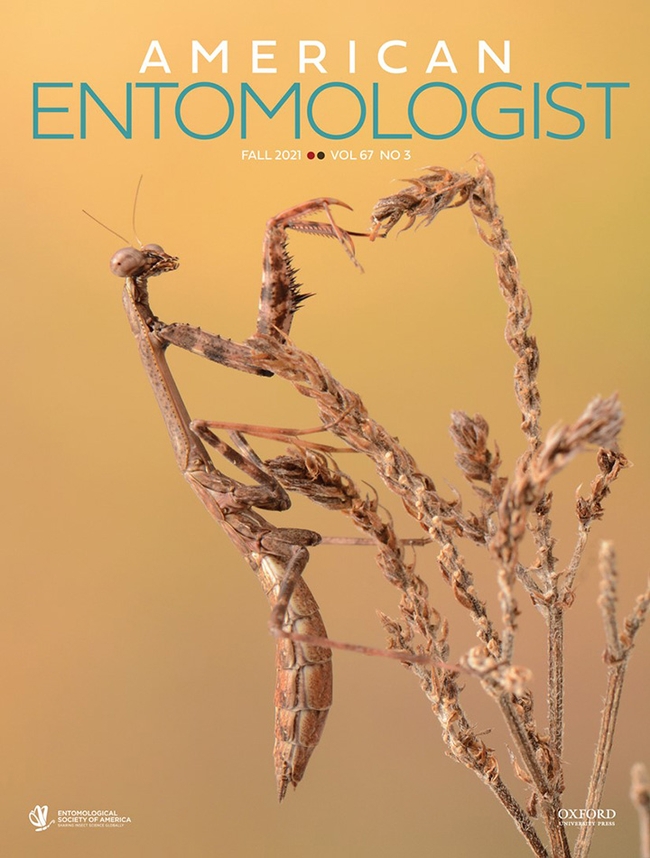
This is his first image selected for the international calendar, although he's submitted a few images over the last several years. He was also honored to have one of his arthropod images selected for the cover of the fall edition of the American Entomologist.
Wright, who holds a bachelor's degree in evolution, ecology and biodiversity from UC Davis in 2008 and a master's degree in evolution, ecology and behavior at the University of Texas, Austin, in 2015, began pursuing photography as a hobby in 2008, using a single lens reflex camera. Today he specializes in macro and wildlife photography but also enjoys "photographing people and, especially, the intersection of people and science."
Wright's hobby has grown into "a passion for documenting the species and behaviors I find during field work or on my many expeditions to observe species and their habitats around the country and the globe."
You can follow Ian Wright on the Internet:
- Website: https://ianmwright.zenfolio.com/
- Facebook: https://www.facebook.com/ian.wright.549
- Twitter: https://twitter.com/ianmwright86
- Instagram: @ianmwright86 and @tinyspheres
The World of Insects Calendar is known for its striking, world-class photography of arthropods. The 2022 calendar drew more than 740 entries from more than 180 photographers from around the globe. The cover image depicts newly hatched brown marmorated stink bug nymphs (Halyomorpha halys), photographed by Tom Astle of Sherman Oaks, Calif.
ESA seeks photos of "the highest aesthetic and technical quality," and issues a call for photos early in the year for the following year's calendar. Photographers of all backgrounds, areas of expertise, career stage, and geographic location submit photos.
This year ESA also published an "Arthropod Photo of the Week" from the submitted photos. (Follow "Arthropod Photo of the Week" via the #arthropodPOTW hashtag on Twitter, Facebook, and Instagram.)
ESA, founded in 1889, serves the professional and scientific needs of entomologists and individuals in related disciplines throughout the world. Its 7000 members are affiliated with educational institutions, health agencies, private industry, and government. They include teachers, extension service personnel, administrators, marketing representatives, research technicians, consultants, students, pest management professionals, and hobbyists.
The general public can order the 2022 calendar online by accessing this link. The cost per calendar is $10 for ESA members and $14 or non-members, with decreased costs for multiple orders.
